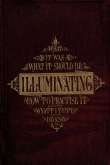You are here
قراءة كتاب The History, Theory, and Practice of Illuminating Condensed from 'The Art of Illuminating' by the same illustrator and author
تنويه: تعرض هنا نبذة من اول ١٠ صفحات فقط من الكتاب الالكتروني، لقراءة الكتاب كاملا اضغط على الزر “اشتر الآن"

The History, Theory, and Practice of Illuminating Condensed from 'The Art of Illuminating' by the same illustrator and author
HISTORICAL MANUAL.
LIST OF PLATES.
Plate I.—From the fragments of the Bible of Charles the Bald, preserved in the British Museum, Harleian 7551. In most of the MSS. of the date of Charlemagne and his immediate successors, the ornamental forms are generally compounded of Anglo-Saxon and semi-classical details; thus, fig. 1 presents us with a lunette, or arch-filling, borrowed from some Latin type; while in figs. 3, 4, 5, the interlaced knots, and in figs. 2 and 6 the "zoomorphic" terminations, are equally characteristic of Celtic art. This class of conventional design, although apparently complicated, is of comparatively easy execution, and on that account forms a suitable style for the young illuminator to try his "'prentice hand" upon.
Plate II. gives the outline of the preceding plate, and the beginner may make his first attempt at practical illumination in an endeavour to make it resemble Plate I. as closely as possible.
Plate III., from the same source as Plate I., gives, in figs. 1 and 4, two alphabets, and in fig. 2 one sentence, in the characters in which the Latin text of the original is written throughout the volume, with the usual form of initial letter; together with, in fig. 3, an ornament showing, on a largish scale, the principle upon which the most common interlacement of the Saxon school is usually worked out.
It may be here noted that, considering it as likely to be more useful to the student, throughout these illuminations the characters, which in the originals express Latin, French, or barbarous English, have been arranged to exhibit Scripture texts of simple language, such as may be frequently desired for the embellishment of churches or schoolrooms.
Plate IV., from the British Museum, Reg. 1, c. vii. This manuscript consists of the Books of Joshua, Judges, and Ruth, in the Vulgate version, with St. Jerome's prologues. It is probably of German execution, and is attributed by Sir Frederick Madden to the middle of the 12th century. In its illustrations may be recognised a series of good specimens of Romanesque forms. In these the scroll may be observed as having almost entirely superseded the Carlovingian interlacement, while in the foliated ends of the leading stems (more particularly in fig. 1) the germination of Gothic is distinctly perceptible. The student will scarcely fail to observe how entirely dependent this style of illumination is upon the steadiness with which the pen is handled for all its charm of expression.
Plate V. gives the outline of the preceding plate, to be coloured as a lesson in shading with the brush.
Plate VI. provides an alphabet of capital letters, some initials, and a complete sentence, taken from the same MS. which has furnished materials for the two preceding plates.
Plate VII. contains fully-coloured examples from the British Museum, Reg. 1 D, fully described at pages 47 and 48. In these we meet with the plenitude of English mediæval illumination,—its freedom of drawing, its vigour of colour, its exquisite delicacy, and the general facility of design its wayward lines attest. In the best work there is a playfulness not to be often found in the productions of the contemporary European schools. It needs but little ingenuity to expand such features as those which constitute figs. 1, 3, 6, 7, 8, from small book embellishments to large motives of elegant mural decoration.
Plate VIII. is the corresponding outline to Plate VII.
Plate IX. supplies the student with models taken from the same MS. (Reg. 1 D), of capital and initial letters, and ordinary text, suitable for combination with the rich ornaments of Plate VII.
In this, as in all corresponding plates, the object aimed at is to provide forms of lettering, at once tolerably legible, well-proportioned, and adapted to harmonize, both historically and artistically, with the styles of pictorial illumination given in connection with them. There are few faults more common in modern work, or more offensive to the educated eye, than the association of styles of lettering and styles of ornamentation warring with each other in the proprieties of both time and form. Against such it is our earnest object to guard the student, both by precept and example.
Plate X. furnishes some specimens of the beautiful borderings which enrich the pages of that most precious relic of the 15th century, the "Bedford Missal," or, more properly speaking, "Book of Hours." This exquisite volume has been so fully dwelt upon at pages 55 and 56, that it is necessary only to refer the reader to the notice given thereat.
In the examples collected on this plate, it is manifest that the pictorial has not been allowed to usurp the proper province of the conventional element of design, as it too frequently does in many works of the same period, particularly in Italy,—undoubtedly beautiful as much of the illumination of the 15th century was in that country.
Plate XI. provides an outline of Plate X., for fully colouring in facsimile.
Plate XII. shows the general style of the lettering, both capital and lower-case, the initials, and the borders which pervade this beautiful triumph of Flemish art. Of these, figs. 3, 4, 5, 6, 7, and 8 are especially adapted for mural decoration, on, of course, a greatly enlarged scale.
M. D. W.
37, Tavistock Place, London.
April, 1861.
TECHNICAL MANUAL.
LIST OF PLATES.
Plate I. is from the


